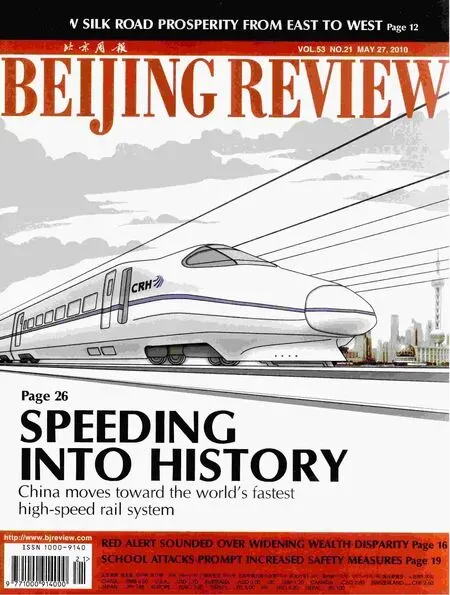Speeding Up
By YU SHUJUN
Speeding Up
By YU SHUJUN
In the wake of the global financial crisis, China has amazed the world with the speed of its economic recovery. But what has been even more surprising is the speed of its railway evolution.
The unveiling of the 1,069-km Wuhan-Guangzhou High-speed Railway on December 26, 2009 pushed China’s high-speed rail system—the total mileage, the average speed and the technology—to rank frst in the world almost overnight.
China formed its ambitious plan to develop a high-speed rail network in 2004, when the country felt the urgency of upgrading its railway system, which had restrained economic development for decades.
It took only four years for the country to roll out its frst high-speed rail line—the Beijing-Tianjin Intercity Railway. Since the Beijing-Tianjin line began operating in August 2008, a high-speed intercity rail network has begun spreading across the country.
People have already experienced the convenience brought by highspeed railways in service today. Travel time has been substantially shortened. Compared with air travel, it’s cheaper, more comfortable and eliminates cumbersome commutes to and from distant airports. With higher capacity and lower energy consumption, the high-speed train is a low-carbon alternative for a country with a huge population and vast territory.
What’s more important are the benefts it brings to the economy. The instant tourism boom in cities along the high-speed lines has already been seen. The high-speed rail network is also essential in balancing regional development. The underdeveloped central and western regions have been and will further be directly linked with coastal cities, which will surely facilitate an industrial transfer from east to west.
This round of high-speed railway construction coincided with the global fnancial turmoil, which helped the country tide over the crisis. Nearly half of the 4-trillion-yuan ($586-billion) stimulus package has been invested in railway construction, which absorbed the excess labor shed by the shrinking export sector and directly boosted other related industries.
Whether a catalyst amid the crisis or an infrastructural booster to the economy, the high-speed rail network is really a necessity in China. It’s no wonder then that U.S. President Barack Obama also outlined plans for a high-speed rail network in the United States. Moreover, the Americans have also shown their interest in China’s expertise in high-speed railway technology and construction. China’s Ministry of Railways has reached agreements with the state of California and General Electric Co. to help build high-speed rail lines by providing technology, equipment and engineers.
And that brings another but more signifcant effect—a face-lift of the past image of cheap, low-end “made-in-China” exports and the emergence of China as a tech-savvy innovator.

